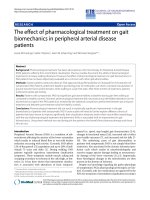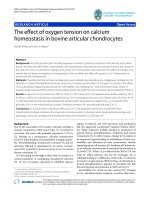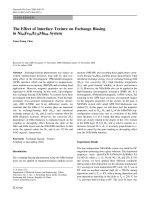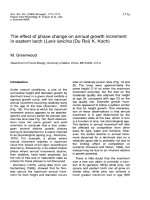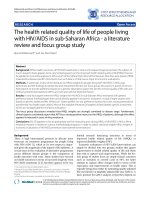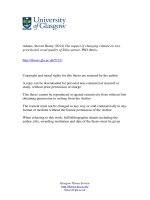The effect of external debt on economic growth in sub – saharan africa
Bạn đang xem bản rút gọn của tài liệu. Xem và tải ngay bản đầy đủ của tài liệu tại đây (1.36 MB, 96 trang )
THE EFFECT OF EXTERNAL DEBT ON ECONOMIC GROWTH IN
SUB – SAHARAN AFRICA
MAHLET KASSAYE
A THESIS SUBMITTED TO
THE CENTER FOR AFRICAN AND ORIENTAL STUDIES
SUBMITTED IN PARTIAL FULFILLMENT OF THE REQUIREMENTS
FOR THE DEGREE OF MASTER OF ARTS IN AFRICAN STUDIES
(HUMAN AND ECONOMIC DEVELOPMENT IN AFRICA)
ADDIS ABABA UNIVERSITY
ADDIS ABABA, ETHIOPIA
JULY, 2017
i
Addis Ababa University
School of Graduate Studies
This is to certify that the thesis prepared by Mahlet Kassaye, entitled: The Effect of External Debt
on Economic Growth in Sub – Saharan Africa and submitted in partial fulfillment of the
requirements for the Degree of Master of Arts in African Studies (Human and Economic
Development in Africa) complies with the regulations of the University and meets the accepted
standards with respect to originality and quality.
Signed by the Examining Committee:
Examiner ____________________________ Signature ___________ Date ______________
Examiner ____________________________ Signature___________ Date ______________
Advisor ____________________________ Signature___________ Date ______________
Chair of Department or Graduate Program Coordinator
ii
ACKNOWLEDGEMENTS
First and above all, glory to be for the Almighty God for making me complete this thesis
successfully and for all the blessings in my life.
My heartfelt thanks and gratitude goes to my advisor, Dr. Kidist Gebreselasie, for her guidance,
constructive and timely comments, unlimited support and welcoming approach in undertaking this
study.
I am also very grateful to my family, thank you for being very much supportive throughout my life.
My sincerest thanks go to my friends and classmates for their encouragement and support. Thank
you all!
i
Table of Contents
Contents
Pages
Acknowledgements .......................................................................................................................... i
Table of Contents ............................................................................................................................ ii
List of Tables ................................................................................................................................. iv
List of Figures ................................................................................................................................. v
List of Acronyms ........................................................................................................................... vi
Abstract ....................................................................................................................................... viii
Chapter One ................................................................................................................................. 1
Introduction..................................................................................................................................... 1
1.1 Background of the Study....................................................................................................... 1
1.2 Statement of the Problem ...................................................................................................... 4
1.3 Objective of the study ........................................................................................................... 8
1.4 Significance of the study ....................................................................................................... 8
1.5 Delimitation of the Study ...................................................................................................... 9
1.6 Organization of the thesis...................................................................................................... 9
Chapter Two ............................................................................................................................. 10
Review of the Literature on External Debt and Economic Growth .............................................. 10
2.1 Theoretical Literature .......................................................................................................... 10
2.1.1 Conceptualizing External Debt, Debt Servicing, Economic Growth and
Convergence .......................................................................................................................... 10
2.1.2 Historical Roots of SSA‗s External Debt ..................................................................... 12
2.1.3 Theories on the External Debt and Growth nexus........................................................ 13
2.1.4 Theories on the negative effect of excessive debt on growth ....................................... 19
2.1.5 The Heavily Indebted Poor Countries Initiative ........................................................... 24
2.2 Empirical Literatures ........................................................................................................... 26
Chapter Three ........................................................................................................................ 32
Research Method .......................................................................................................................... 32
3.1 Model Specification ............................................................................................................ 32
3.1.1 Theoretical Model......................................................................................................... 32
3.1.2 Empirical Model ........................................................................................................... 37
ii
3.2 Variables Included in the Model ......................................................................................... 38
3.2.1 Variables and their expected signs ............................................................................... 45
3.3 Data description and source of data .................................................................................... 46
3.4 Estimation Method .............................................................................................................. 46
3.4.1 The General Method of Moments (GMM) ................................................................... 46
3.4.2 Testing for Stationarity ................................................................................................. 50
3.4.3 Testing for Consistency ................................................................................................ 51
3.4.4 Testing for Multicollinearity ........................................................................................ 52
3.4.5 Testing for Heteroskedasticity...................................................................................... 52
Chapter Four.............................................................................................................................. 53
4. Results and Discussion ............................................................................................................. 53
4.1 Descriptive Statistics and trends in per capita GDP growth and Debt ................................ 53
4.1.1 Trends in Per capita GDP growth across the HIPCs SSA ............................................ 54
4.1.2 Trends in External Debt Stock across the HIPC, SSA ................................................. 56
4.1.3 Trends in debt servicing across the HIPC of SSA ........................................................ 58
4.2 Test Results ......................................................................................................................... 60
4.2.1 Levin-Lin-Chu test for Stationarity .............................................................................. 60
4.2.2 Arellano - Bond test for Autocorrelation...................................................................... 61
4.2.3 Pairwise test for Multicollinearity ................................................................................ 62
3.2.4 Test for Heteroskedasticity......................................................................................... 63
4.3 Econometric Results............................................................................................................ 63
4.3.1 The Effect of Debt Stock on Growth across the HIPC of SSA .................................... 65
4.3.2 The Effect of Debt Servicing on Growth across the HIPC of SSA .............................. 66
4.3.3 Evidence of Convergence/Divergence in Growth across the HIPC of SSA ................ 68
4.3.4 Other variables affecting growth across the HIPC of SSA .......................................... 68
Chapter Five ............................................................................................................................. 70
Conclusion .................................................................................................................................... 70
References .................................................................................................................................. 72
Appendices................................................................................................................................ 79
iii
List of Tables
Table 3.1 Variable description and their expected signs .............................................................. 45
Table 4.1 Descriptive statistics of the variables included in the estimation (1996-2015) ............ 53
Table 4.2 unit root test result for Levin-Lin-Chu (LLC) test........................................................ 61
Table 4.3 Arellano –Bond test for autocorrelation ....................................................................... 62
Table 4.4 Pairwise test for multicollinearity................................................................................. 62
Table 4.5: dynamic panel –data estimation, two - step GMM results .......................................... 64
iv
List of Figures
Figure 2.1.The Debt Laffer curve ........................................................................................ 21
Figure 4.1 Average per capita GDP growth rate during 1996-2015 .................................... 55
Figure 4.2 Average per capita GDP growth rate among HIPC-SSA (1996-2015) .............. 56
Figure 4.3 External debt stocks (% of GNI) for HIPC of SSA during 1996-2015 .............. 57
Figure 4.4 External debt stocks (% of GNI) among HIPC-SSA during (1996-2015) . ....... 58
Figure 4.5 Total debt servicing (% of GNI) for HIPC of SSA during (1996-2015) ........... 59
Figure 4.6 Total debt servicing (% of GNI) among HIPC-SSA during (1996-2015) ....... 60
v
ACRONYMS AND ABBREVIATIONS
ADF
African Development Fund
BOP
Balance of Payment
COC
Control of Corruption
DEDH
Direct Effect of Debt Hypothesis
DPD
Dynamic Panel Data
FONDAD
Forum on Debt and Development
GDP
Gross Domestic Product
GMM
General Method of Moments
GNI
Gross National Income
GNP
Gross National Product
HIPC
Heavily Indebted Poor Countries
ICOR
Incremental Capital - Output Ratio
IDA
International Development Agency
IFIs
International Financial Institutions
IMF
International Monetary Fund
LDCs
Least Developed Countries
LLC
Levin-Lin-Chu
MDGs
Millennium Development Goals
MDRI
Multilateral Debt Relief Initiatives
OLS
Ordinary Least Square
OPEC
Organization of Petroleum Exporting Countries
PRGF
Poverty Reduction and Growth Facility
vi
PRSP
Poverty Reduction Strategy Paper
SAPs
Structural Adjustment Programs
SOEs
State Owned Enterprises
SSA
Sub - Saharan African
USD
United States Dollar
WB
World Bank
WDI
World Development Indicators
WGI
Worldwide Governance Indicators
vii
ABSTRACT
The Effect of External Debt on Economic Growth in Sub – Saharan Africa
Mahlet Kassaye
Addis Ababa University, 2017
The effect of external debt on economic growth continuous to be a debatable issue among
scholars, policy makers and advocates. This study examines the impact of excessive debt
accumulation on economic growth in the heavily indebted poor countries (HIPC) found in
Sub – Saharan Africa (SSA) during the period (1996 – 2015) using two – step GMM
estimation technique. It also assesses weather the debt cancellations under the HIPC
initiative contributes for growth in SSA. Results show that excessive external debt
accumulation is adversely affecting the growth rate of per capita GDP possibly through its
overhang and crowding out effects, whereas debt forgiveness under the HIPC initiative is
found to have a significant and positive effect on the growth rate of per capita GDP in SSA.
Debt coming as a package with a relief initiative can positively contribute to growth in HIPC
- SSA. In other words, if debt is to benefit SSA, it should be accompanied by cancellation
which is uncertain since it is a decision in the hands of the creditors.
Key Words: Debt cancellation, Economic growth, External Debt, HIPC initiative, SSA
viii
Chapter One
Introduction
1.1 Background of the Study
Most Sub - Saharan African (SSA) countries obtained their independence in 1960s.By 1966,
75% of the region was free from the colonial rules (Crowder, 1987). Following the global
hike up of commodity prices, the growth performance of many countries in the region
improved till early 1970s. According to Collins et al., (1996), the political independence and
economic growth goes hand in hand and this is manifested by the more rapid growth in SSA
during the period 1960 – 1972 than the first half of the 20thcentury with a growth structure
better than southern Asian countries.
Starting from early 1970s, SSA countries started to face a deteriorating economic
performance and a declining social and human development records which were even worse
than the colonial times. The region observed a rising poverty, inequality, deteriorating terms
of trade, lack of social service provision and most of the countries were unable to continue
the huge infrastructural projects which they were building with a dream of attracting future
investment opportunities (Moyo, 2009). In 1980s things became worse with social unrest and
springing protracted civil wars and as a result the economy of SSA became totally dependent
on external debt and foreign aid with, the external debt burden reached US$235.94 billion
making up 71.95% of the GDP by 1995 (Fiagbe, 2015).
Scholars gave various international, regional as well as country specific explanations for
SSA‘s indebtedness though they fail to point out the exact factors and remedies. For
1
example, Fosu(1996, 1999), Iyoha(1999), Fole (2003) and Ayadi (2008) indicated that the
major factors for Africa‘s indebtedness are: the oil price shocks of the 1970s and their
aftermath which includes high interest rates, recession in industrial countries and the
subsequent commodity price fall and high inflation rates in Africa. Many also argue that a
rise in public expenditure, low institutional development/quality and unwise policy measures
by African governments contributed to the situation (Todaro et al., 2012).
According to Elbadawi (2000), the lack of capital faced by African nations pushed them for
borrowing. He argues that entrepreneurship and capital do not actually exist in Africa and
when many states needed a good push to move their economies they went towards the
developed countries to borrow capital . In many instances, the countries failed to pay back
both the debt and its arrears which eventually led to a serious and severe disaster termed as
debt crisis.
According to Fole (2003), Africa‘s debt crisis has to do with the cumulative effect of the
negative trade balances the continent has registered since the time of European conquest and
industrial revolution, which through process created a dependent, easily vulnerable and
fragile economy. He argues that before the conquest, the continent had full autonomy in its
economic ties and was capable of producing world class products and fulfilling the basic
needs of the African society, but colonialism created a dependent Africa with no bargaining
power. In the process, African countries were pushed to specialize in providing a single
commodity to the world market which worsened the scale of their debt burden. Supporting
this argument FONDAD (1992), states that protectionism on agricultural and low technology
2
products made it double difficult for African countries to come out of the debt trap since it
made it difficult to earn sufficient hard currency from export.
Others blame the political landscape of Africa and its tyrant leaders who practice unlimited
power and unaccountable leadership for Africa‘s debt crisis. It is believed that majority of the
money incurred by SSA as debt is odious and went to the pocket of leaders, affiliated
political officials and their close relatives either for personal use or huge army building rather
than state building. For instance only two African leaders, Mobutu of former Zaire and
Abacha of Nigeria looted an estimated sum of US$10 billion from their respective countries
(Transparency International (2007) cited in Moyo, 2009).
Still others blame the loose administration of the international financial system as well as the
influence of the developed world in using International Financial Institutions (IFIs) to pursue
their own agenda through channeling huge funds (Moyo). As a result, African countries
ended up getting huge funds even to service their debts and the IFIs were providing debt
knowing it has no positive returns and used for non-development purposes. The institutions
were providing huge sum of money and floating concessional loans through different
stabilization policies and Structural Adjustment Programs (SAPs) without considering the
countries‘ repaying ability; further impacts on growth, and sustainability of the continent‘s
overall development (Todaro et al., 2012).
In effect, most SSA countries became so burdened and overwhelmed by huge external debt
stocks and debt-service obligations that their overall economies and particularly the financial
3
systems are seriously damaged as they struggle to come out of the debt trap. According to the
World Bank (1999), out of the 39 Heavily Indebted Poor Countries (HIPC), 33 are found in
SSA. Poverty is also becoming irreversible in SSA and even after providing the so called
debt relief and cancellations more than 50% of SSA remains to live below the poverty lines,
earning less than $1.25 a day (World Bank).
1.2 Statement of the Problem
Growth theories have established the role of saving and investment for stimulating growth.
Historical records also proved that countries that achieved and sustained growth in the long
run are those that maintained high domestic saving rates sufficient to support their domestic
investment (Todaro et al., 2012). Similar with other developing regions, SSA regularly faces
capital shortage and widening gap between the amount of savings and investment needs.
According to Elbadawi (2000) private and public savings have been declining as a share of
GDP in SSA. Based on the success stories of the developed world, developing countries are
advised to fill the saving – investment gap through foreign aid and/or borrowing since they
have a very poor record of domestic capital formation which causes SSAs dependency on
external capital (Ndikumana, 2014).
Indebtedness is considered as one of the contemporary development problems faced by the
developing world. This issue attracted many researchers although the focus was more on
assessing the causes of indebtedness for Latin American countries especially after Mexico
defaulted on its debt obligations (Fiagbe, 2015).The level of external debt in SSA has been
steadily increasing for the last couple of decades. The external debt stock of SSA countries
4
reached US$360 billion in 2013 from US$67 billion in 1980,UD$168 billion in 1990,
US$206 billion in 2000 and US$268 billion in 2010 respectively (IMF 2015;cited in Hamid,
2015).
The level of debt notwithstanding, the growth performance of SSA has been deteriorating
with GDP growth rates kept at minimum or even below zero in some cases. Real GDP
growth was 5.32 % on average between 2000 and 2010 which started to decline afterwards,
registering only a 4.22 % and 4.07 % growth in 2011 and 2013 respectively (Fiagbe,2015).
Accompanied by low growth performances poverty continues to be an immense challenge for
SSA with the poor increasing from 217 million in 1987 to 384 million in 2005 which is the
highest percentage in the world for any region, and it is also with the greatest increase in the
number of poor people both numerically and proportionally (WB cited in Todaro et al.,
2012).
Debt-driven capital flights continue to be a bottleneck for growth in SSA. According to
Ndikumana et al., (2011) the borrowed funds have not been financing the development
projects as intended; in contrast, the money ended up in private pockets of government
officials with the support of the financers and banks. They found that33 SSA countries that
have debt arrears of US$177 billion in 2008 had an estimated capital flight record of about
US$944 billion in between 1970-2008. This situation highly burdened African people with
servicing debt.
External debt can affect the economy through debt overhang and crowding out effects. Based
on the debt overhang hypothesis debt has a negative impact on the economy after it reaches a
certain threshold level (Nguyen et al., 2003).This threshold level is estimated at around 50 %
5
of GDP for the face value of external debt, 20–25 % of GDP for its estimated net present
value or 100–105 % as a ratio to exports (Nguyen et al.,). On the other hand, paying for
external debt took the money away from public service investments and other development
projects. According to Ndikumana et al.,(2011) the costs of reckless lending-borrowing
practices in SSA are beyond financial problems where an additional dollar of debt servicing
implies to 29 fewer cents spent on public health and a reduction of US$ 40,000 through debt
servicing leads to one additional infant death. Based on this, the African debt service
payments are estimated to be equivalent to more than 75,000 infant deaths each year
(Ndikumana et al.,).
Many countries fall into debt crowding out effect as public investment is adversely affected
by servicing external debt. Since debt servicing is mostly done by using foreign currencies
and particularly the dollar, it drains the foreign exchange reserves of the debtor country
through capital flights. SSA countries engaged in exporting primary products so their export
earnings is too small even to finance their imports and provide social services under normal
conditions let alone to paying the debt arrears (Moyo,2009). According to Ndinkumana and
Boyce (2003), for every dollar of external borrowing by a SSA country in a given year, on
average 80 cents left the country as capital flight and will continue to cause an increment in
capital flight for consecutive years. This indicates that the capital flight exceeds the debt
stock itself as it causes investment to flow out of the country.
On the other hand finding physical capital through borrowing from different sources has a
tendency to boost economic growth in different parts of the world. Some of the literature
considers the development successes of war torn Europe, South Korea and Japan‘s economic
performance as borrowing – led Moyo (2009). It is believed that these countries have
6
benefited a lot from foreign borrowing in becoming leading economics of the world.
According to Fiagbe (2015), theoretically this phenomenon is supported since capital
generated from domestic sources is very scarce to sufficiently meet the investment targets of
the countries at their early stages of growth also ample empirical evidences supporting the
theories. Uzun et al., (2012), found out that external debt has a positive impact on boosting
investment in emerging economies of the world. Similarly, Warner (1992), Khan and Kumar
(1997), Bhatto (2010), Zaman and Arslan (2014), and many others argue that external debt
has a positive contribution for economic growth.
In general even if the issue of debt and debt servicing seems to be only financial problems its
effects are multi-dimensional touching economic, political and social spheres. Although there
is a significant difference among the debt positions of individual countries in SSA, it is very
difficult to address the growth and development issues the region is facing without properly
addressing the questions raised concerning external debt and growth in the region. Although
there are many researches conducted on the debt growth nexus almost all are focused on
assessing the channels through which debt influences growth, none of them examined the
effect of HIPC initiatives on growth for SSA aggregate. This research will try to see the
impact of external debt on economic growth through assessing the contributions of debt
treatments done under the HIPC initiatives for HIPC of SSA.
7
1.3 Objective of the study
The objective of this study is to examine the effect of external debt on economic growth in
Sub-Saharan African countries and test the convergence hypothesis for HIPCs of SSA.
Specifically the study sets out to achieve the following specific objectives:
examine the trends of external debt stock and debt servicing for SSA.
analyze the effect of indebtedness on the economic growth performance of SSA.
assess the role of HIPC initiative for economic growth in SSA.
investigate the existence of convergence in growth among the HIPCs in SSA.
1.4 Significance of the study
The African debt problem is one among the myriads of problems the continent is facing
(Fole, 2003).Although there is a significant difference among the debt positions of individual
countries in SSA, almost all countries in the region are struggling a lot with debt related
issues. The SSA region comprises 33 of the 39 HIPC as categorized by the WB and IMF,
(1996). Studying the trends of debt stock and debt servicing as well as the debt – growth
nexus is necessary and not only because it is one of the contemporary economic issues of the
region but also because it has showed direct and indirect long lasting impacts on growth
throughout the region.
Solving financial constraints using external borrowing did not help in taking the SSA region
out of stagnant economic situations for the last couple of decades. Scholars, politicians,
policy makers and advocates admit that the arrears of debt servicing become a burden for the
infant economy of SSA and worked towards debt relief and cancellation since mid-1990‘s to
8
help SSA achieve the Millennium Development Goals (MDG‘s) and minimize the level of
poverty. However many countries of SSA continue to remain in unsustainable debt burden
having consecutive and severe financial constraints causing economic stagnation and chaos
that calls for more empirical research.
1.5 Delimitation of the Study
There are 47 countries found in SSA. Of which 33 are HIPC. This study used –countries of
the HIPC SSA by excluding Sao Tome and Principe, Somalia, Sudan and Eritrea. Sao Tome
and Principe is excluded due to lack of sufficient data on the key variables included in the
estimation whereas Somalia, Sudan and Eritrea are excluded as they are not yet eligible for
full debt relief and cancellation since they are in the pre – decision stage. The study only
focuses on countries in the Completion Point in order to get unbiased outcome regarding the
guidance of HIPC initiative.
1.6 Organization of the thesis
The remaining part of the thesis is organized as follows. Chapter two reviews the theoretical
and empirical literature concerning the external debt - growth nexus as well as the impact of
indebtedness on growth in SSA and developing regions in general. Chapter three then
presents the theoretical and empirical models as well as the variables and estimation
technique for the study. Chapter four presents the data analysis and results of the study. The
last chapter summarizes the main conclusion drawn from the study.
9
Chapter Two
Review of the Literature on External Debt and Economic Growth
2.1 Theoretical Literature
In this section, the theoretical foundations of external debt, economic growth, convergence
and debt growth nexus will be presented. Even if the crucial role of capital for growth is
established both theoretically and empirically since the classical times, the relationship
between external debt and economic growth continues to be controversial. Theoretical
models which analyze the debt growth nexus found out mixed results showing positive and
negative relationships.
2.1.1 Conceptualizing External Debt, Debt Servicing, Economic Growth and
Convergence
External debt refers to the total private and public foreign debt owed by a country. The WB
defines external debt as ―the outstanding amount of those actual current, and not contingent,
liabilities that require payment(s) of principal and/or interest by the debtor at some point(s) in
the future and that are owed to nonresidents by residents of an economy which is repayable
in foreign currency, goods or services in at any given time.‖, External debt is usually owed
for two major purposes higher investment or/and higher consumption which domestic
resources cannot support which in the long run facilitates economic growth and improves
standard of living (Fiagbe, 2015).
Total debt service is the arrear of the debt which includes both the sum of principal
repayments and interest actually paid in foreign currency, goods, or services (WB). In most
10
cases the currency of the lender‘s country serves as the standard currency to service external
debt regardless of the exchange rate differences between the currencies. However, in a
situation where countries involved use same currency, the borrower customarily repays the
debt in its own currency (Fiagbe, 2015).
Economic Growth is an increase in the nation‘s productive capacity and shows the rate at
which a country‘s economy grows over time. It is usually measured as the annual percentage
rate of growth of the country‘s major national income accounting aggregates, such as the
Gross National Product (GNP) or the Gross Domestic Product (GDP) with appropriate
statistical adjustments to discount the potentially misleading effects of price inflation
(Johnson, 2000)
The convergence hypothesis states that countries with relatively low levels of initial per
capita income grow faster than those with high levels of initial per capita income so that over
time income levels converge across countries. This hypothesis has led to differences between
the two leading economic growth theories – the neoclassical and endogenous growth models.
The Solow model predicts that growth rates in output and income per capita converge to a
constant and identical levels across countries, and regions where as the advocates of
endogenous growth models Barro & Sala-I-Martin (1992, 1995), Jones (1995), Mankiw et
al., (1992) emphasize that a number of factors may influence growth convergence which
includes the existence of diminishing returns to capital within each country or region; spatial
capital or/and labour mobility; and the diffusion of innovations across countries and regions.
11
2.1.2 Historical Roots of SSA’s External Debt
It is very difficult to see the SSA debt crises in separation from the global debt crises that
occurred since early 1980s. Too much borrowing by developing countries combined with
liberal lending of foreign commercial banks in 1970s; the fall in commodity prices in the
early 1980s, particularly for petroleum products; and the very large increase in international
lending rate in 1982 are some of the major factors behind the debt crises in SSA(Todaro et
al.,2012). Before the 1982‘s global debt crisis, most non-oil exporting developing countries
depended on foreign borrowing to make up for their BOP deficits which is caused by current
account deficits and increased from 8.7 billion US$ in 1973 to US$ 42.9 billion in 1974 and
US$ 51.3 billion in 1975 due to oil price shocks occurred from 1973 to 1979 (Fiagbe, 2015).
Being triggered by the Arab - Israel and the Iraq - Iran war respectively, the quadruple
increase in oil prices by the Organization of Petroleum Exporting Countries (OPEC) made
huge oil cash available for International Commercial Banks which increased their liquidity to
lend abundantly to countries including SSA without any record of creditworthiness (Todaro
et al .,2012).
By early 1982, there was a sudden drop in oil prices followed by a rapid increase in
international lending rate which caused BOP problems in many countries. Mexico followed
by other Latin American countries was pioneer to publicize its debt crises. In August 1982
the Mexican government announced its inability to service its debt of $80 billion owed to
international lenders. This was considered as the first sign of the international debt crisis by
many scholars. Looking at Africa, indebtedness rose significantly from US$ 130 billion in
1973 to US$ 336billion in 1978 and in SSA alone eleven countries namely Angola,
12
Cameroon, Congo, Ivory Coast, Gabon, The Gambia, Mozambique, Niger, Nigeria, Tanzania
and Zambia defaulted on their debt obligations, Moyo (2009), Ejigayehu (2013).
2.1.3 Theories on the External Debt and Growth nexus
Economic theories suggest that reasonable levels of borrowing by a developing country can
enhance economic growth since countries at early stages of development face capital
shortage. According to these theories developing countries have better returns on investment
when compared with developed countries and as long as they use the borrowed funds for
productive investment purposes and as far as they face no economic distortions they would
not face a debt burden since the increase in growth allows them for timely debt servicing
(Pattillo et al., 2004). The positive growth effect of debt is implicitly embedded on theories
supporting the positive growth effect of capital accumulation. Some of these theories which
directly or implicitly acknowledge the role of debt for growth are the Harrod – Domar
growth model, The Solow- Swanson model, The Keynesian model and the endogenous
growth model which are discussed in what follows.
i.
The Harrod-Domar Growth Model
The Harrod-Domar growth model is the simplest and most known production function used
in the analysis of economic development, which is developed by Harrod (1939) and Domar
(1946), primarily to explain the relationship between growth and unemployment in an
advanced capitalist society. The model has been used extensively in LDCs to examine the
relationship between capital requirements and growth. The model, assumes that economic
growth is a direct result of capital accumulation in the form of saving and has been
13
intensively used to estimate the financing gap of a developing economy. By assuming
abundant labor supply this theory claims capital scarcity as the only growth constraint for
developing countries (Effendi, 2001).
The Harrod – Domar model asserts that growth is proportional to the rate of investment,
which depends on the level of national saving and the productivity of capital investment (the
capital output ratio), (Todaro et al., 2012). The model helps to find the saving investment gap
which is mathematically calculated by multiplying the targeted growth rate with the capital
output ratio. This model advocates the use of imported foreign capital to stimulate growth
(Suma, 2007).
The model also articulates that the growth rate of national income is directly related to the
saving ratio and inversely related to capital-output ratio. On theoretical grounds, the HarrodDomar
growth model suffers a shortcoming, by which the equilibrium is unstable since it
requires the equalization of warranted and natural growth rates and for using production
function with little suitability among inputs (Scarfe, 1977). As described by, Foday (2007)
the production function used in this model is of Leontief type with fixed proportion and no
substitutability of factors. Although the huge capital injection saved the war torn Europe,
empirical evidences do not, however, support this theory in the context of developing
countries since the massive external debt that has accumulated in developing countries since
the 1960s was accompanied by neither economic growth nor investment.
14
ii.
The Solow – Swan Model
The Solow – Swan (1956) model was developed independently by Robert Solow and Trevor
Swan in 1956. The model targets to address the question of why rich countries are so rich and
why the poor ones are so poor? This model which is developed based on Cobb – Douglass
production function reveals constant returns to scale, diminishing returns to each input, and
positive substitutability to inputs. The production function is assumed to be a function of
capital, labor and technology and states that economies will conditionally converge to the
same level of income if they have the same rates of savings, depreciation, labor force growth,
and productivity growth. This model serves as the basic framework for the study of
convergence across countries (Todaro et al., 2012).
The model states that an increase in saving, which is reflected in investment, will generate
additional growth in the short run. However, as the ratio of capital to labor increases, the
marginal product of capital will decline and the economy will go back to a steady state which
makes output, capital, and labor grow at the same rate. Hence growth in per capita income
continues and equals the annual rate of productivity improvements (Suma, 2007).
Based on this model total capital accumulation depends on the change in capital per worker
which is a function of investment per worker, depreciation per worker and population growth
(Ejigayehu,2013).Total capital stock grows when saving is greater than depreciation, and
capital per worker grows when saving is greater than what is needed to equip new workers
with the same amount of capital as the existing workers and as we increase the capital
accumulation by raising the rate of savings, there exists a temporary increase in the rate of
15




